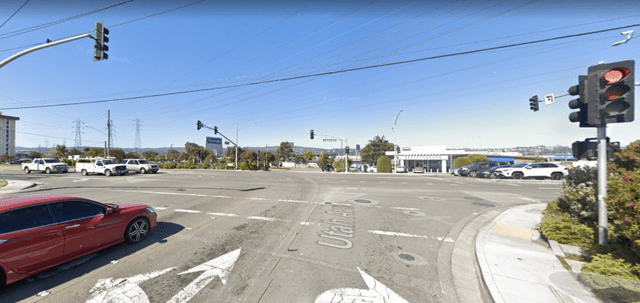Note: GJEL Accident Attorneys regularly sponsors coverage on Streetsblog San Francisco and Streetsblog California. Unless noted in the story, GJEL Accident Attorneys is not consulted for the content or editorial direction of the sponsored content.
Caltrans District 4 is funding yet another traffic-inducing, pollution-generating freeway widening, this time in South San Francisco. From tipster, transportation planner, and local advocate Darryl Yip:
The City of South San Francisco recently published a draft environmental impact report to expand a freeway overpass and widen an interchange via the US Highway 101/Produce Avenue Interchange Project. In the report, the city falsely concludes that the project has “no impact” on increasing vehicle miles traveled, leading to faulty conclusions on environmental justice, air quality, climate change, and consistency with local and regional plans.
The project, starting construction in 2025 at a cost of at least $112 million, will require commercial property acquisitions. To give the appearance of being an environmentally sane project, it will also include painted "Class II" bike lanes. Going by the documents and images, it is another equivalent to the hellscape overpasses Caltrans built a few years ago connecting the Jingletown and Fruitvale portions of Oakland. That project, which was sold as a way to reconnect neighborhoods, converted streets into de-facto freeway ramps with sidewalks on only one side and pedestrians banned from crossing almost anywhere. The striped, gutter-pan bike lanes it included could be described as somewhere between utterly unusable and deadly.
Yip, who is also a member of the city's Bicycle and Pedestrian Advisory Committee, wrote the following in an email to Caltrans and the City of South San Francisco:
We are South San Francisco residents with backgrounds in transportation planning, education, and climate advocacy. As such, we can say with confidence that the DEIR for this project does not follow CEQA Guidelines 2022 to adequately evaluate the full impact of induced demand on vehicle miles traveled, and, therefore, fails to accurately account for the negative impacts it will have on the environment and surrounding vulnerable communities.
Readers will recall that back in 2019, Governor Gavin Newsom vetoed S.B. 127, legislation that would have forced Caltrans to start building bicycle and pedestrian-friendly facilities. In its place, via an executive order, Caltrans said it would start incorporating the needs of bike riders and pedestrians into its projects. But as Streetsblog warned, the agency simply can't be trusted to do that. This is just the latest in a line of projects that, unfortunately, continues to prove that point.
For a list of the ongoing road-widening, polluting, and carnage-inducing projects on Caltrans' Bay Area agenda, click here (a few on the list are not highways and one or two include decent bike facilities, but there are still many retrograde projects just like the US Highway 101/Produce Avenue Interchange).
"The bicycle lanes made of paint do not support [the] Climate Action Plan or General Plan with goals to reduce the need to drive, and are not a mitigation strategy for the induced demand the project will cause as they will not create the mode shift needed to support those plans," wrote Yip in his email to Streetsblog. "Next step is that the city is going to have to respond to my DEIR public comment, then it will likely rush the project to approval to prevent any slow down. I've already connected with other groups to put political pressure on the city council to stop the project."






